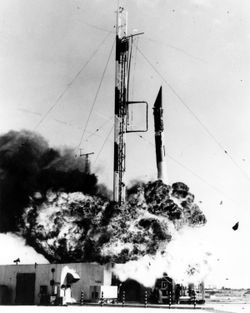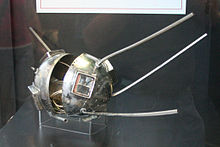- Vanguard TV3
-
"Kaputnik" redirects here. For the David Berg character, see Roger Kaputnik.
Vanguard TV3 
The Vanguard rocket explodes shortly after launch.Operator Naval Research Laboratory (NRL) Mission type Earth science Satellite of Earth Launch date December 6, 1957 at 16:44:34 UTC Launch vehicle Vanguard rocket COSPAR ID VAGT3 Homepage NSSDC Master Catalog Mass 1.36 kg[1] Vanguard TV3 was the first attempt of the United States to launch a satellite into orbit around the Earth. It was a small satellite designed to test the launch capabilities of the three-stage Vanguard rocket and study the effects of the environment on a satellite and its systems in Earth orbit. It was also to be used to obtain geodetic measurements through orbit analysis.
At its launch attempt on December 6, 1957 at Cape Canaveral, the booster ignited and began to rise; but about two seconds after liftoff, after rising about four feet (1.2 m), the rocket lost thrust and began to fall back to the launch pad. As it settled the fuel tanks ruptured and exploded, destroying the rocket and severely damaging the launch pad. The Vanguard satellite was thrown clear and landed on the ground a short distance away with its transmitters still sending out a beacon signal. The satellite was damaged, however, and could not be reused. It is now on display at the National Air and Space Museum of the Smithsonian Institution.[1]
The exact cause of the accident was never determined with certainty,[2] but the commonly accepted explanation is that low fuel tank pressure during the start procedure allowed some of the burning fuel in the combustion chamber to leak into the fuel system through the injector head before full propellant pressure was obtained from the turbopump.
Contents
Satellite design
The payload was a 1.36 kg aluminum sphere 152 mm in diameter, nearly identical to the later Vanguard 1. It contained a mercury battery powered, 10 mW, 108 MHz transmitter and a 5 mW, 108.03 MHz transmitter powered by six solar cells mounted on the body of the satellite. Six short aerials protruded from the sphere. The transmitters were used primarily for engineering and tracking data, but were also used to determine the total electron content between the satellite and ground stations. Vanguard also carried two thermistors to measure the interior temperatures in order to track the effectiveness of the thermal protection.
Engineers recovered the payload from the launch area, still functioning. It was restored and put on display at the entrance to the Apollo gallery when the National Air and Space Museum opened in 1976. Since then the display has been modified to show TV3 in a condition closer to what it was found in.
Reaction
As a result of the launch failure, trading in the stock of the Martin Company, prime contractor for the project, was temporarily suspended by the New York Stock Exchange.[2]
Newspapers in the United States, published prominent headlines and articles noting the failure including plays on the name of the Russian satellite, Sputnik, such as "Flopnik",[3] "Kaputnik",[4] "Oopsnik", and "Stayputnik".[5]
Later analysis of this technological failure characterized this as a humiliation and loss of prestige for the United States which had presented itself to the world as the leader in science and technology. Its rival in the Cold War, the Soviet Union exploited this at the time.[6][7]
External links
- YouTube - Vanguard TV3
- Google Newspapers - The Ottawan Citizen - "US fails to fire Satellite"
References
- ^ a b "Vanguard TV3". NSSDC Master Catalog. NSSDC, NASA. http://nssdc.gsfc.nasa.gov/nmc/spacecraftDisplay.do?id=VAGT3. Retrieved 2011-02-26.
- ^ a b McLaughlin Green, Constance; Lomask, Milton (1970). "Chapter 11: From Sputnik I to TV-3". Vanguard - A History. NASA. http://www.hq.nasa.gov/office/pao/History/SP-4202/cover.htm. Retrieved 2011-02-26.
- ^ Sparrow, Giles (2007). Space Flight. Dorling Kindersley. ISBN 075662858X.
- ^ Burrows, William E. (1999). This New Ocean: The Story of the First Space Age. Modern Library. p. 205. ISBN 0375754857.
- ^ Alan Boyle (1997-10-04). "Sputnik started space race, anxiety". MSNBC. http://www.msnbc.msn.com/id/3077890/. Retrieved 2008-03-17.
- ^ Catchpole, John (2001). Project Mercury: NASA's First Manned Space Program. p. 56. ISBN 1852334061.
- ^ Jones, Thomas (2002). "Early Frustrations: Project Kaboom (A.K.A Vanguard)". Complete Idiots Guide to NASA. ISBN 0028642821.
Project Vanguard Orbital launches in 1957 · 1958 → Payloads are separated by bullets ( · ), launches by pipes ( | ). Manned flights are indicated in bold text. Uncatalogued launch failures are listed in italics. Payloads deployed from other spacecraft are denoted in brackets.Categories:- 1957 in spaceflight
- Project Vanguard
- Satellite launch failures
- Individual spacecraft in the collection of the Smithsonian Institution
Wikimedia Foundation. 2010.

